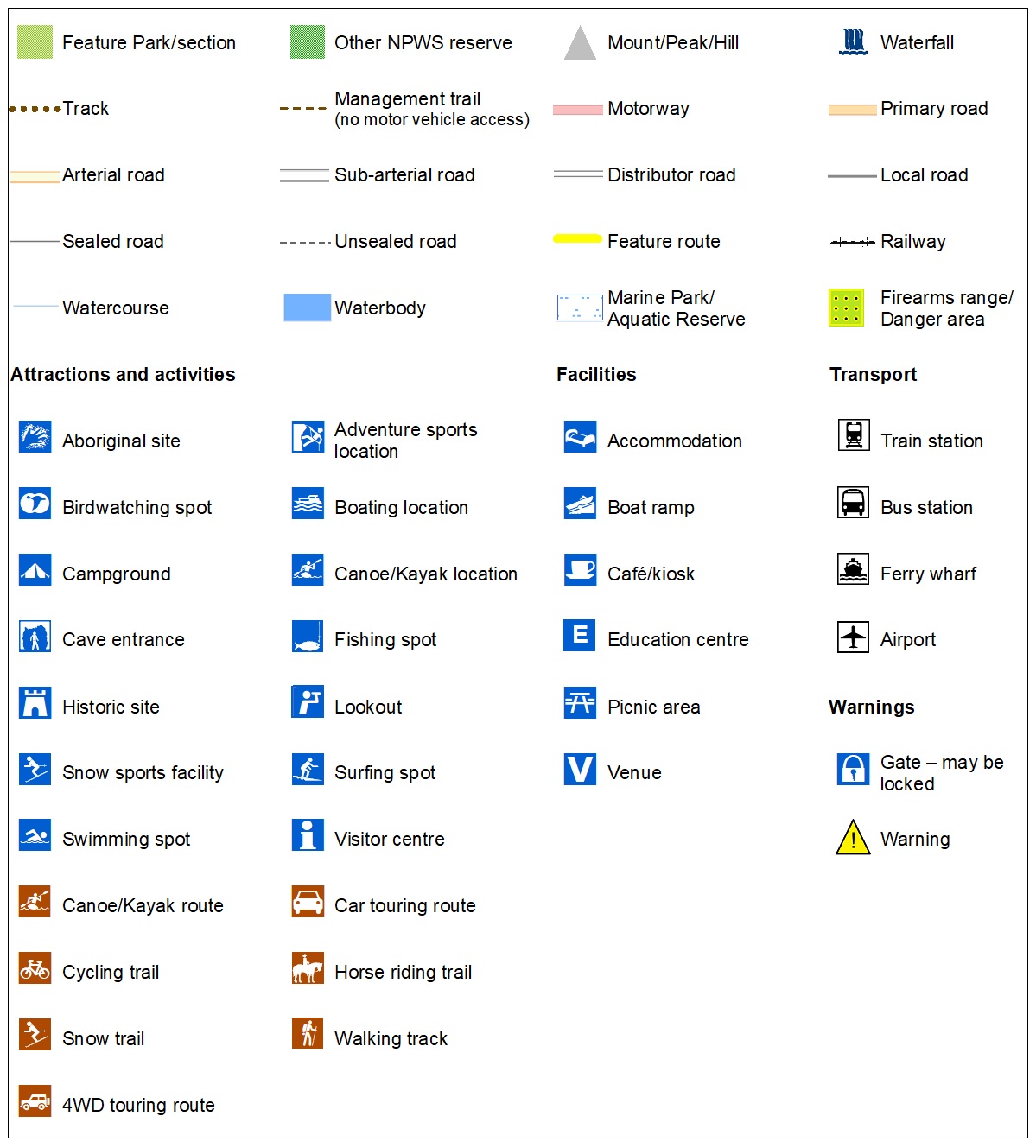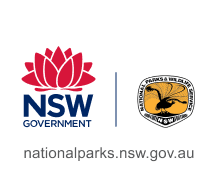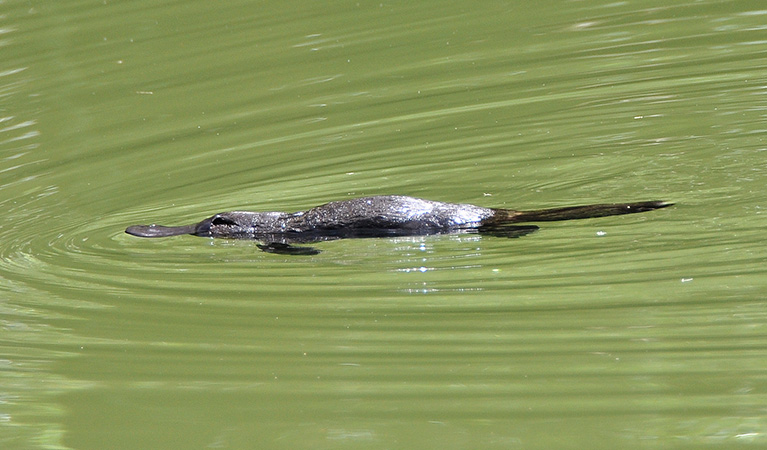Jenolan River walking track
Jenolan Karst Conservation Reserve
Affected by closures, check current alerts
Overview
Jenolan River walking track and Blue Lake are closed for road repairs and upgrades until 2026.
- Distance
- 2.6km return
- Time suggested
- 45min - 1hr 30min
- Grade
- Grade 3
- Please note
- Swimming is prohibited in Blue Lake, as it's an important platypus habitat. You can swim at the waterhole downstream, below the waterfall along Jenolan River walk.
- Check with the ticket office for walking track advice or closures before you set out.
Jenolan River walking track is closed until 2026 while Transport for NSW repairs flood-damaged roads and landslips. During this time, NPWS and Jenolan Caves Trust will also work to upgrade the accommodation, walking tracks and access to caves.
Jenolan River walking track takes in amazing Blue Lake, waterfalls, bridges and Jenolan Caves' hydro-electric heritage. Also called Working Waters walk, it's great for bird watching and wildlife spotting.
It’s hard not to feel energised by the natural beauty along Jenolan River walking track. Also known as Working Waters walk, this easy walk at Jenolan Caves is suitable for almost everyone, all year round.
Starting from the eastern side of Grand Arch the track provides great views looking back up to Carlotta Arch, as it traces the edge of beautiful Blue Lake. See if you can spot the trout ladder next to the hydro hut, or glimpse the lake's resident platypus.
To make the most of this walk, why not pack a picnic lunch to enjoy beside the vibrant waters of Blue Lake.
Continue beyond the lake's weir, following the Jenolan River through woodland downstream. Detour to the bottom of the small waterfall and swimming hole. While you can't swim in Blue Lake, you can enjoy a dip at this scenic spot.
For a shorter walk, return to Grand Arch. Or, follow the track further downstream along the hillside to reach the old Jenolan Hydro Electric Power Station and picnic area.
Bird watchers are in for a treat, with bellbirds, rock warblers and lyrebirds often spotted amongst the area’s woodland. Goannas, kangaroos, wallabies and eastern water dragons are also never far away.
Also see
-

Carlotta Arch walking track
Carlotta Arch walking track is closed until 2026 while Transport for NSW repairs flood-damaged roads and landslips.
-

McKeown's Valley walking track
McKeown's Valley walking track is closed for road repairs and upgrades until 2026.
Map

Map

Map legend

Local alerts
For the latest updates on fires, closures and other alerts in this area, see https://www.nationalparks.nsw.gov.au/things-to-do/walking-tracks/jenolan-river-walking-track/local-alerts
General enquiries
- National Parks Contact Centre
- 7am to 7pm daily
- 1300 072 757 (13000 PARKS) for the cost of a local call within Australia excluding mobiles
- parks.info@environment.nsw.gov.au
Park info
- in Jenolan Karst Conservation Reserve in the Sydney and surrounds region
This reserve is closed until 2026. For more information, check the Jenolan Caves website.
Visitor info
All the practical information you need to know about Jenolan River walking track.
Track grading
Features of this track
Distance
2.6km return
Time
45min - 1hr 30min
Quality of markings
Sign posted
Experience required
Some bushwalking experience recommended
Gradient
Short steep hills
Steps
Many steps
Quality of path
Formed track, some obstacles
Getting there and parking
Get driving directions
Jenolan River walking track is in Jenolan Karst Conservation Reserve. Access to Jenolan on Jenolan Caves Road (5-Mile Road) is closed indefinitely. The only access is via Edith Road (2-Mile Road). This road is suitable for standard vehicles only. There is no access to Jenolan for caravans, trailers or any vehicle longer than a 12-seat minibus.
From Sydney:
- Travel west on the M4, which becomes the Great Western Highway at the foot of the mountains.
- Pass through Katoomba and Blackheath and turn left onto Jenolan Caves Road at Hartley.
- Drive through Hampton and turn right onto Duckmaloi Road. Do not continue along Jenolan Caves Road, access is closed.
- Continue along Duckmaoi Road for 20km, then turn left onto Titania Road.
- At the end of Titania Road, turn left onto Edith Road and continue until you reach Jenolan.
From Goulburn:
- Take Taralga Road out of Goulburn and travel north towards Taralga.
- Pass through Taralga and continue north on Taralga Road towards Oberon. Taralga Road turns into Abercrombie Road at the Abercrombie River.
- At Black Springs, turn right and continue on Abercrombie Road.
- At Oberon, turn right onto O’Connell Road and then left onto Carrington Avenue.
- Turn right onto Ross Street, then turn left onto Edith Road and continue until you reach Jenolan.
Please note:
- The last 5km of Edith Road is steep, narrow and winding, with several hairpin bends. Drive carefully and allow yourself plenty of time.
- Edith Road is not suitable for caravans, trailers or any vehicle longer than a 12-seat minibus.
- Traffic in and out of Jenolan is regulated for safety. Please check Live Traffic NSW before you set out.
Road quality
- Sealed roads
Vehicle access
- 2WD vehicles
Weather restrictions
- All weather
Parking
- Parking is available at any of the 3 main carparks at Jenolan Caves. It can be a busy place on the weekend, so parking might be limited.
- Designated disabled parking spots can be found next to the Guides Office and behind Caves House.
- Bus parking is also available.
Facilities
The nearest toilet facilities are located at the Jenolan Caves ticket and information office.
You'll need to bring your own supply of drinking water.
Maps and downloads
Prohibited
Swimming is prohibited in Blue Lake, as it's an important platypus habitat. You can swim at the waterhole downstream, below the waterfall along Jenolan River walk.
Pets
Pets and domestic animals (other than certified assistance animals) are not permitted. Find out which regional parks allow dog walking and see the pets in parks policy for more information.
Smoking
NSW national parks are no smoking areas.
Learn more
Jenolan River walking track is in Jenolan Karst Conservation Reserve. Here are just some of the reasons why this park is special:
Binomil

The beautiful and mysterious Jenolan Caves holds special significance to the Gundungurra people who knew it as 'Binoomea' meaning 'dark places'. According to Gundungurra Elder, Old Jimmy Lynch, Aboriginal people knew the caves, carrying sick people as far as the subterranean water which they believed to have great curative powers. The Dreamtime myth of Gurrangatch relates to the forming of Wombeyan and Jenolan Caves. The caves are said to have been formed during a contest between Gurrangatch, a mythical being that was part fish and part reptile, and Mirragan, a legendary tiger cat.
Greater Blue Mountains Area World Heritage Property

It is truly amazing to think that a city the size of Sydney has a large World Heritage Area on its doorstep. The World Heritage listing recognises the geographic, botanic and cultural values of the area. The forests of the Greater Blue Mountains Area World Heritage Property have been described as a natural laboratory for the evolution of eucalypts; and more than 90 different eucalypt species occur here, some 13 per cent of all eucalypt species in the world. They grow in a great variety of communities, from tall closed forests, through open forests and woodlands, to the stunted mallee shrublands on the plateaus.
Historic tourism

Jenolan Caves is one of Australia's first tourist attractions; with land having first been set aside for public recreation and enjoyment in 1866. In the years following this, a number of buildings were constructed, the most notable being Caves House; an excellent example of early Victorian architecture and comfortable heritage accommodation. Innovations in engineering and cave lighting are evident - particularly in Chifley Cave. There are more than 300 caves within the Reserve, all containing a range of geological features and formations, like stalactites and stalagmites, plus rarer helictites and stromatolites The best way to find out about the caves is on a guided or self-guided tour. There are eleven caves to choose from.
- Jenolan River walking track Jenolan River walking track and Blue Lake are closed for road repairs and upgrades until 2026.
- McKeown's Valley walking track McKeown's Valley walking track is closed for road repairs and upgrades until 2026.
Plants and animals protected in this park
Animals
-

Eastern bentwing-bat (Miniopterus schreibersii oceanensis)
Eastern bentwing-bats congregate in caves across the east and north-west coasts of Australia, in colonies of up to 150,000. These small Australian animals weigh around 13-17g and can reach speeds of up to 50km per hour. Eastern bentwing-bats use both sight and echolocation to catch small insects mid-air.
-

Platypus (Ornithorhynchus anatinus)
One of the most fascinating and unusual Australian animals, the duck-billed platypus, along with the echidna, are the only known monotremes, or egg-laying mammals, in existence. The platypus is generally found in permanent river systems and lakes in southern and eastern NSW and east and west of the Great Dividing Range.
-

Common brushtail possum (Trichosurus vulpecula)
One of the most widespread of Australian tree-dwelling marsupials, the common brushtail possum is found across most of NSW in woodlands, rainforests and urban areas. With strong claws, a prehensile tail and opposable digits, these native Australian animals are well-adapted for life amongst the trees.
-

Bare-nosed wombat (Vombatus ursinus)
A large, squat marsupial, the Australian bare-nosed wombat is a burrowing mammal found in coastal forests and mountain ranges across NSW and Victoria. The only other remaining species of wombat in NSW, the endangered southern hairy-nosed wombat, was considered extinct until relatively recently.
-

Short-beaked echidna (Tachyglossus aculeatus)
One of only 2 egg-laying mammals in the world, the short-beaked echidna is one of the most widespread of Australian native animals. Covered in spines, or quills, they’re equipped with a keen sense of smell and a tube-like snout which they use to break apart termite mounds in search of ants.
-

Spotted-tailed quoll (Dasyurus maculatus)
The spotted-tailed quoll is the largest remaining carnivorous marsupial on the Australian mainland. It’s protected as a vulnerable species in NSW.

